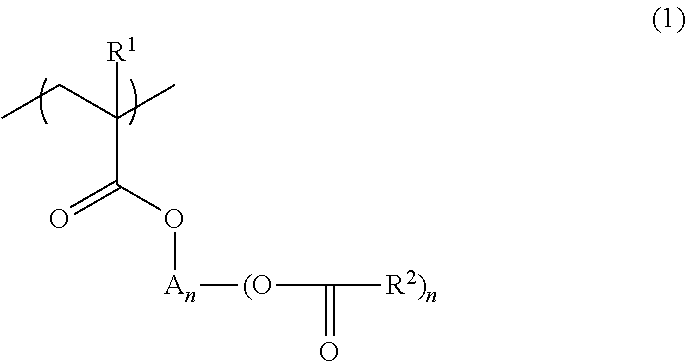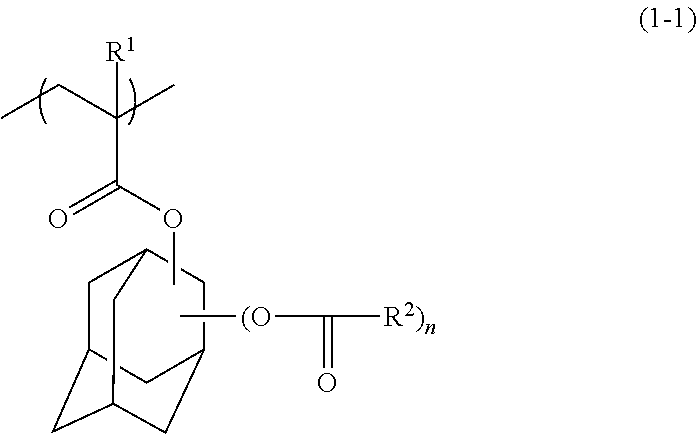Polymer, resist composition, and patterning process
- Summary
- Abstract
- Description
- Claims
- Application Information
AI Technical Summary
Benefits of technology
Problems solved by technology
Method used
Image
Examples
synthesis example 1
Monomer Synthesis Example 1
Synthesis of Monomer 1
[0156]
[0157]A 10-L four-necked flask was charged with 800 g of 3,5-dihydroxy-1-adamantyl methacrylate and 3 L of toluene. With the flask ice cooled, 552 g of pyridine was added and the contents were thoroughly stirred. While the flask was maintained at a temperature below 15° C., 465 g of trifluoroacetic anhydride was added dropwise over 4 hours. Stirring was continued for a further 17 hours. With ice cooling, 1,000 g of water was poured into the flask. This was followed by ordinary post-treatment and vacuum distillation, obtaining 1,377 g of the target compound (yield 97.8%).
[0158]Boiling point: 108-111° C. / 20 Pa
[0159]1H-NMR (300 MHz in CDCl3):
[0160]δ=1.90 (3H, m), 2.10-2.25 (6H, m), 2.55-2.75 (7H, m), 5.56 (1H, m), 6.04 (1H, m) ppm
[0161]13C-NMR (75 MHz in CDCl3):
[0162]δ=18.19, 29.11, 38.25, 38.38, 43.29, 43.41, 79.00, 84.38, 114.13 (q, J=285 Hz), 125.92, 136.81, 155.68 (q, J=42 Hz), 166.05 ppm
[0163]19F-NMR (283 MHz in CDCl3, trifluo...
synthesis example 2
Monomer Synthesis Example 2
Synthesis of Monomer 2
[0165]
[0166]While a mixture of 12.5 g 3,5-dihydroxy-1-adamantyl methacrylate, 9.9 g pyridine, and 90 g toluene was ice cooled and stirred in a nitrogen atmosphere, 36.9 g of pentafluoropropionic anhydride was added dropwise to the mixture below 15° C. Stirring was continued for 2 hours, after which 50 g of deionized water was added dropwise to the reaction solution to quench the reaction. This was followed by ordinary post-treatment and vacuum distillation, obtaining 26.3 g of the target compound (yield 97.5%).
[0167]Boiling point: 105° C. / 10 Pa
[0168]1H-NMR (300 MHz in CDCl3):
[0169]δ=1.55-1.70 (2H, m), 1.90 (3H, m), 2.10-2.25 (6H, m), 2.57-2.73 (7H, m), 5.57 (1H, m), 6.05 (1H, m) ppm
[0170]13C-NMR (75 MHz in CDCl3):
[0171]δ=18.21, 29.25, 38.32, 38.48, 43.47, 43.53, 79.08, 84.91, 105.65 (tq, J=265, 40 Hz), 120.29 (tq, J=287, 34 Hz), 125.99, 136.95, 156.67 (t, J=29 Hz), 166.16 ppm
[0172]19F-NMR (283 MHz in CDCl3, trifluoroacetic acid standa...
synthesis example 3
Monomer Synthesis Example 3
Synthesis of Monomer 3
[0174]
[0175]While a mixture of 50.0 g 3-hydroxy-1-adamantyl methacrylate, 20.1 g pyridine, and 150 g acetonitrile was ice cooled and stirred in a nitrogen atmosphere, 53.4 g of trifluoroacetic anhydride was added dropwise to the mixture below 10° C. Stirring was continued for 1 hour, after which 200 g of hexane and 200 g of deionized water were successively added dropwise to the reaction solution to quench the reaction. This was followed by ordinary post-treatment and vacuum distillation, obtaining 67.9 g of the target compound (yield 96.4%).
[0176]Boiling point: 89° C. / 20 Pa
[0177]1H-NMR (300 MHz in CDCl3):
[0178]δ=1.55-1.70 (2H, m), 1.89 (3H, m), 2.05-2.25 (8H, m), 2.44 (2H, m), 2.59 (2H, m), 5.52 (1H, m), 6.02 (1H, m) ppm
[0179]13C-NMR (75 MHz in CDCl3):
[0180]δ=18.28, 31.23, 34.51, 39.61, 39.69, 44.74, 80.36, 86.49, 114.27 (q, J=285 Hz), 125.08, 137.43, 155.77 (q, J=41 Hz), 166.25 ppm
[0181]19F-NMR (283 MHz in CDCl3, trifluoroacetic aci...
PUM
| Property | Measurement | Unit |
|---|---|---|
| Time | aaaaa | aaaaa |
| Percent by mass | aaaaa | aaaaa |
| Nanoscale particle size | aaaaa | aaaaa |
Abstract
Description
Claims
Application Information
 Login to View More
Login to View More - Generate Ideas
- Intellectual Property
- Life Sciences
- Materials
- Tech Scout
- Unparalleled Data Quality
- Higher Quality Content
- 60% Fewer Hallucinations
Browse by: Latest US Patents, China's latest patents, Technical Efficacy Thesaurus, Application Domain, Technology Topic, Popular Technical Reports.
© 2025 PatSnap. All rights reserved.Legal|Privacy policy|Modern Slavery Act Transparency Statement|Sitemap|About US| Contact US: help@patsnap.com



